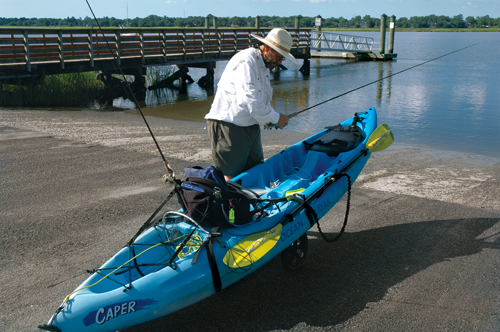Embarking on even a short paddling trip requires some forethought and planning. Follow the tips and visit the resources below to make sure your trip on the Southeast Coast Saltwater Paddling Trail is a safe one!
Conditions and Navigation | Communications | Equipment | Safety Gear | Clothing

Kayaker prepares for launch near Charleston, SC. Photo credit: Phillip Jones/SC DNR
Conditions and Navigation
- Research the section of the water trail that you are paddling using pertinent maps, NOAA charts and tide charts.
- Know the abilities of your group and don’t exceed these.
- Watch out for boat traffic both large and small. Some of the trail includes the Intracoastal Waterway. In other areas, local boaters will be in speed boats, jet skis and other motorized craft that can be dangerous to kayakers.
- The tides are significant along the Southeast coast. Carry tide tables and navigation charts. “Ride the tide” so that you use it in your favor. The tides greatly affect your paddle times.
- Know the water levels and speed of the currents and tides.
- Carry a deck compass, or GPS and map of the trail. Know where you are, where your access points are and how to get out in an emergency.
- If you are camping, make sure you know the approved camping locations. Know if the camp sites are primitive or developed and pack the appropriate equipment.
- Check the forecast but always be prepared for quick changes in the weather.
Resources
- Georgia
- North Carolina
- South Carolina
- Virginia
Communications
- Notify friends or family of your paddle itinerary. Make sure they know who to contact if you don’t return on time. Write down where you intend to put in, take out and when you expect to return.
- For emergencies, call 911, but assume the coverage will be inadequate.
- If you are planning for an extended trip, consider a satellite phone, a VHF Marine radio, or a SPOT Personal satellite tracking system (can give outgoing message where cell phones do not work). Make sure everyone in your party knows how to operate the emergency equipment. Consider what power source to use for this equipment.
- Carry a marine whistle, bell or horn within easy reach for low visibility conditions.
- Carry flashlights and visual signal device or light sticks, or flare gun and flares.
- Carry waterproof GPS and extra batteries
Equipment
- Wear a U.S. Coast Guard approved personal flotation device (pfd) and keep it snug.
- Assess your boat’s flotation needs. For flotation to work effectively it must fit snugly into the craft and be securely tied into place.
- A lightweight paddle and spare paddle.
- For trips of greater distance and duration, make sure your kayak has a rudder suitable for open water.
- Dry bags & chart case for paddle guide & maps, cell phone, cameras, laptops, GPS, other important items.
- First aid kit and personal medications.
- Food and water—1 gal/person/day. Carry more than you think you need.
- Gear specifically for overnight trips.
- Sprayskirt/cockpit cover for rough and windy conditions.
- Waterproof matches.
- Extra batteries
Safety Gear
- Be prepared for bad weather. Open water along the coast changes quickly and rough seas can develop with a small change to wind direction.
- Carry throw bags and other rescue gear. Make sure you can use them.
- Carry a boat knife–when there are ropes and rigging, a knife is needed; this includes throw bags and throw ropes.
- Pack a bilge pump and/or bailer so that you can reach it while paddling. Especially important in open water. Always carry some device that can get water OUT of the boat.
- Self-rescue devices such as paddle float, slings, and tow ropes
- Duct tape/small repair kit
- Know how to re-enter your boat if you flip.
- Be able to secure all gear to the boat (better to use the storage compartments) so nothing is lost to high waves washing over your boat or wind gusts.
Clothing
- Always carry clothing to protect from wind and rain that can quickly compromise your safety and cause hypothermia, even in warm weather. Dress in layers. Temperature changes can occur rapidly even in summer
- Know the warning signs of hypothermia—even in warm weather.
- Carry insect repellent, sunscreen, hats, sunglasses (with UV eye protection) and a strap.
- Proper footwear–especially important if you will be near any oyster beds or climbing on any structures with barnacles. Assume that you will need protection.

